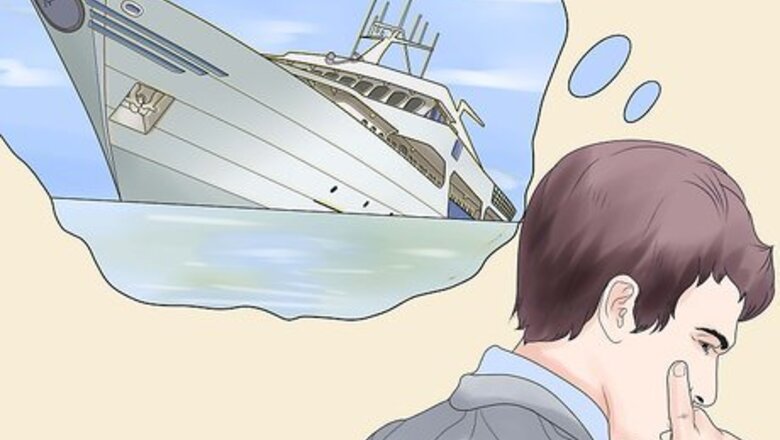
views
Learning the Basics: Before Setting Sail
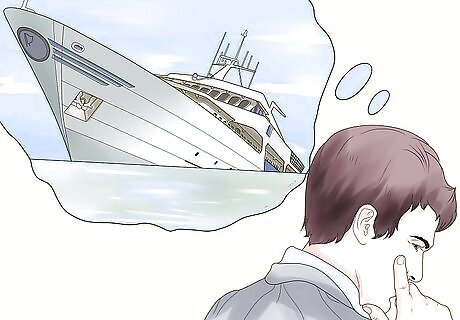
Understand the mechanics behind a sinking ship. While this is mainly for the sake of curiosity, understanding how a ship sinks can be useful and give you a sense of what occurs if you're ever stuck in the situation of being on a sinking ship. Every type of ship will react to taking on water and sinking differently depending on the shape of the hull, center of gravity, and cause of the casualty. No one set of rules works on all ship types. Water often enters the lowest point of a ship first, the bilge area. The bilges are pits in the lowest part of the engineering section. It's very normal for ships to have water leaking into the bilges. It comes in through sea chests, shaft bearings, or valve seals. Ships have bilge pumps to remove this water once it reaches a certain level. They are in the bilges to attack any eventual flooding as early as possible at the lowest possible level. However, this is not always a viable solution. Ships can sink from hitting another ship, an object such as an iceberg, a ruptured sea chest, or an attack. In the case of the Greek cruise liner MTS Oceanos the water entered through a ruptured overboard sewage discharge valve far from the bilges and erupted into the ship through commodes, sinks, and showers. There was no way the pumps could have helped. The Titanic had seams popped and split starting about 50 feet (15.2 m) from the starboard bow and flooded 6 compartments. The rest is history. There was just too much water for the pumps to discharge. The Lusitania was torpedoed and exploded twice. Both the MS Sea Diamond and the Costa Concordia ran aground and partially sank after hitting well marked reefs while sailing in good weather. There are many other famous examples. Small boats will react differently than bigger ships. They are normally built, as much as possible, of buoyant materials. Reasons for why a boat might sink include a low transom, missing drain plugs, cooling system leaks, or openings either incorrectly closed or broken doors (such as on a car ferry). The broken doors are what sank the car ferry Estonia.
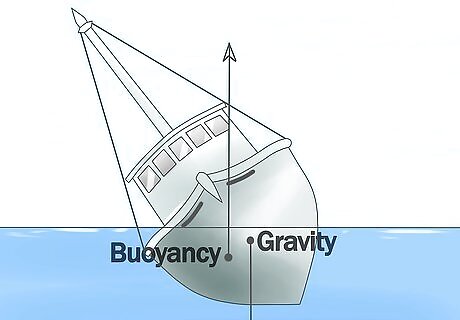
Learn how the Estonia sank. The stability of a ship depends, in part, on its center of gravity. In the case of the Estonia the car ferry took on water through a broken door. In that event, the rocking slowed down, which is a bad sign because a ferry that isn't rocking cannot stabilize itself. With Trans-Oceanic ships the configuration is different. According to researcher Steve Zalek of the University of Michigan Naval Architecture and Marine Engineering Department, Marine Hydrodynamics Laboratory, studies done demonstrate that if the center of gravity is low the ship will rock quickly. Passengers will become seasick, cargo can break loose, and containers can be pitched into the sea, but if the center of gravity is higher the ship will rock more slowly. Passengers will be more comfortable, cargo won't break loose, and containers aren't pitched overboard. Rocking too much could cause a ship to keel over in heavy seas. The idea is that the ship would heel over to no more than 10° either way in order when the wheel is thrown hard over to maintain stability.
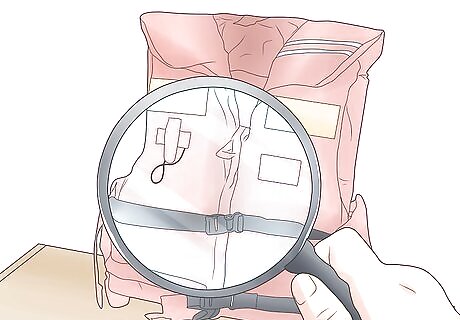
Check for the location of personal flotation devices. Ensure you do this as soon as you have boarded any sea vessel. Whether you're going on a short trip across the harbor, a day trip, or a cruise, knowing the location of the personal flotation device in advance may save your life. When going on a cruise, part of the standard safety drill at the beginning will include asking you to check that your PFD is in the cabin space. Be sure to check for infant or child PFDs if also needed and alert crew immediately if these are not in place. In addition, look for the lifeboats nearest to your cabin, along with any obvious markers that might lead you to the boats if visibility becomes bad; as with aircraft, there will often be lights designating where safety exits are. Read the instructions for putting on the personal flotation device and using it. If you have any questions, ask the ship's crew. If you're traveling on a ship where the crew speaks a different language from your own, find people who can advise you directly on what to do in the event of an emergency. It is prudent to seek this information even before you board the ship.

Think about your sense of etiquette. Although philosophical in nature, the question is: What will you do if push came to shove? Would you expect to see women and children off first, then men? Or is it everyone for themselves? This actually depends upon the laws of what national waters the ship is in first, and the flag registry or nation of ownership second. Women and children boarded lifeboats from the Titanic because she was in international waters, and flagged in England, whose laws demanded such action- and they had time to board lifeboats. However, Lusitania sank in 18 minutes, giving no one time to board life boats.
Evacuating, if Sinking is Imminent
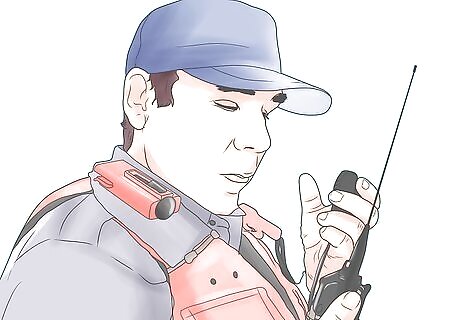
Send out a Mayday if you're in charge of the sinking ship. Read How to call Mayday from a marine vessel to learn how to do this.
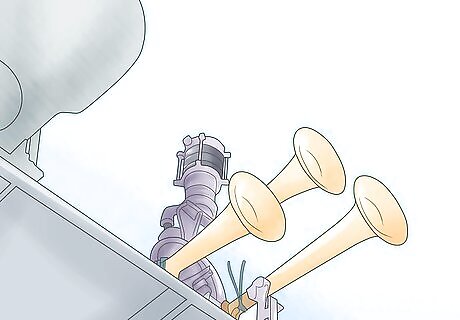
Listen for the evacuation signal. This is standard – 7 short horn blasts followed by one long one. The captain or other crew members may also use the intercom system to speak to all other crew and passengers.

Put on your personal flotation device (PFD). Be as prepared to exit the ship as time allows. If you have time to grab any additional survival items, do so. But only if doing so won't endanger your life or the lives of others. If you have time, put on all your waterproof gear, such as headgear, jacket, and gloves. If there is an emergency survival suit available and time permits, put it on. Note that while survival suits increase your chances of surviving in cold water, they are unlikely to be provided on passenger ships. For crew who have access to such suits, they will usually be required to practice putting on this suit within 2 minutes. Attend to all infants, children, and pets after you've prepared yourself. On a cruise ship, your life jacket is usually located in a cupboard near the entryway of your stateroom. Head straight to your stateroom, grab your life vest, take a small travel bag, put on something warm and comfortable, and only grab essential foods and medications. Then go straight to your designated muster station by following the emergency exit signs.

Follow directions. This may be the most important step of all. If you don't know how to get to safety, the captain or one of the crew members will tell you how. Ship's crews are highly trained in rescue operations on many ships and will have a better understanding than you about what needs to be done to ensure your safety. You should only attempt to escape on your own if there is no authority present to give proper directions. A well-run ship will have a "muster station" where everyone needs to gather in preparation for evacuation. If you received a safety drill in going to a muster station, try to comply with it. If you can't hear or understand the directions (for example, it's not your language), keep one thing in mind - head up and off the ship. Heading to the center or inner levels of the boat is not wise but don't be surprised if people do this as a result of panic. If the captain assigns you with tasks, speak up if you don't feel you can comply. Otherwise, do your best to help out.

Stay calm and don't panic. It may sound like an inevitable cliché, but the more you panic, the longer it will take to get to a lifeboat. Studies have shown that only about 15 percent of people manage not to panic, with a whopping 70 percent suffering from impaired reasoning and 15 percent becoming irrational. Thus, staying calm is important for dealing with other passengers as well as helping to keep your own mind focused to do whatever you can to survive. If others around you are panicking, try as best you can to calm them down, as their actions will only slow down and possibly endanger your evacuation. Unfortunately, panic on a cruise is something that can endanger everyone owing to the number of people involved and this can lead people to push and shove one another, causing injuries before people have even left the ship. Be aware that the opposite spectrum of panic can kick in – that of being stunned and unable to respond at all. If you see someone frozen with fear, yell at them. This is what flight attendants are trained to do to get passengers to leave a burning plane, and can be adapted to a boat situation. Try to focus on keeping your breathing under control. If you're used to breathing for yoga, pilates, or any similar relaxation breathing techniques, use these to calm you, as well as resorting to breathing this way if you end up in the water trying to survive.
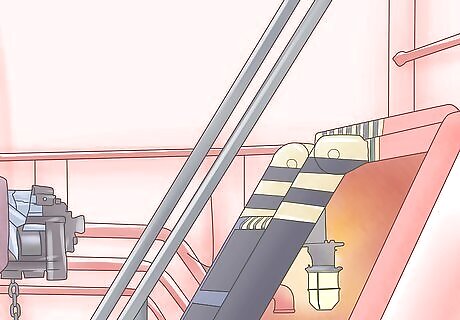
Focus on escaping via the quickest route, not the shortest route. Getting out fast is more important than getting out by going the shortest way which might even lead you to more danger. As the ship begins to tilt, grab whatever you can to help you remain upright and able to reach your destination, such as handrails, pipes, hooks, light fittings, etc. Do not take the elevator. Just as you should avoid elevators when escaping a fire, the same applies here; all electrically driven items are suspect. The last place you'll want to be on a sinking ship is stranded in an elevator. In most cases, there will be no electricity on the ship, and the ship's list angle will be too great for an elevator to properly function. While still in the inner deck areas, watch for catapulting or floating objects coming your way. Large items hitting you can knock you unconscious or kill you. Ships are equipped with emergency strip lighting that make it clear which way is the exit in the event of a fire. If the lighting changes color such as from green to red or direction such as straight to left, then this marks the exit route.
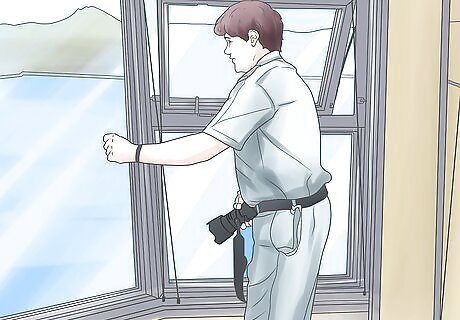
Make your way to the deck. From there, head to your emergency station or the nearest lifeboat available. Most of today's cruise liners run safety drills and procedures prior to departing on voyages so that passengers know where to go in the event of an emergency. If not, head to where it seems that the crew are assisting passengers to escape. Crew will usually be the last to abandon ship, as it is their duty to get everyone else off the ship to possible safety first. Don't play the hero by staying back while crew is on board. Do what needs to be done to ensure that survival of yourself and your loved ones is not compromised. This isn't the movies.

Find a lifeboat. The very best scenario is to enter a lifeboat without getting wet. The moment you're wet, you risk getting hypothermia or suffering from cold shock (see below). If lifeboats are already deployed, head for the best place to enter or jump into them, following instructions of crew if relevant. If there are no lifeboats available, try to find a life preserver ring or similar flotation device and toss it into the water. Any flotation device is better than none, although your survival chances decrease dramatically once you're forced to spend time in the water. You may need to jump off the ship, or in some cases, simply step off an incline. If there is a lifeboat nearby, swim to it, wave your arms, and shout to attract attention. If jumping, always look first. There may be people, boats, fires, propellers, etc., in the water below that you could hit or be submerged in. The ideal scenario is getting straight into a lifeboat. If not, the next best scenario is to jump as close to a rescue boat as possible and make your way into it immediately.
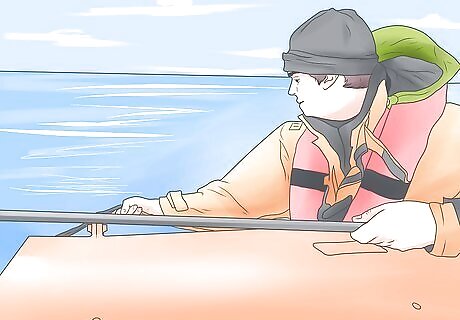
Stay calm in the lifeboat. Follow directions, and wait for the rescue. Waiting alone in the open ocean without the comfort of a large ship will undoubtedly be frightening, but be patient. Help is on the way. In a lifeboat, use rations sparingly. Use flares only when it is clear that doing so will result in a rescuer seeing you. Huddle together to keep warm. Arrange lookout watches. Collect rainwater and don't drink seawater or urine. Treat any injuries as best you can. Stay determined. Stories of survivors at sea are a testament that it is the most determined who survive harsh waiting conditions leading up to rescue. If you couldn't find a lifeboat, look for the next best things, such as a life raft, or bobbing objects from the ship (flotsam) that remain afloat.

Expect some harsh realities. If you don't end up in a lifeboat either straight away or fairly quickly, your survival odds worsen a great deal. The sea is cold and if it's rough, even the strongest swimmers will have a hard time defeating the cold and the sea swells. Inadequate amounts of lifeboats or lost lifeboats mean that there can be more people than space, causing more panic and even endangering the remaining lifeboats as people desperately cling to them or clamber on. Being in cold water will cause hypothermia. Hypothermia will cause you to want to sleep. If you fall asleep or fall unconscious, you risk drowning. Cold shock is the kind of shock that comes from hitting cold water and being unable to control your breathing while your heart rate and blood pressure go up, immediately incapacitating you. Cold shock can cause you to take an involuntary breath, which will often cause you to take in water. While those who are used to entering cold water can tolerate this for initial few minutes required to regain your senses, many people are not able to do so and drown. This cold shock phenomenon occurs before hypothermia sets in. Shock may set in, causing everything to become surreal and to prevent you from doing your best to survive. If shock doesn't set in, mental distress is a highly likely possibility, with nothing but water everywhere, right to the horizon, and not knowing when rescue will arrive. Try to prevent this by focusing on surviving, using mind games, counting, thinking about other people's needs, etc. Your hands and fingers will become numb very quickly, making even doing up a lifejacket difficult, if not impossible. Even in good weather, heatstroke, sunburn, and dehydration soon become an issue. Try to cover yourself up as best you can and ration water supplies carefully. If you do survive, be ready for the reality that some of the people on the lifeboat with you may not. Seek counseling for post-traumatic stress disorder if needed.














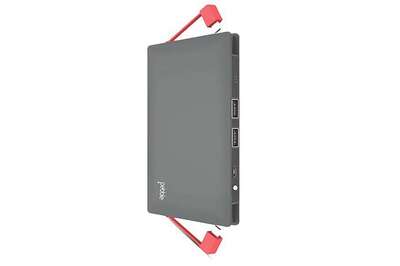





Comments
0 comment